In this part, we are going to discuss how to deploy data-center with one cluster which contains our two hosts in the RHEV environment. Both of two hosts connected to shared storage, additional to previous preparation, we will add another CentOS6.6 virtual machine acts as storage node.
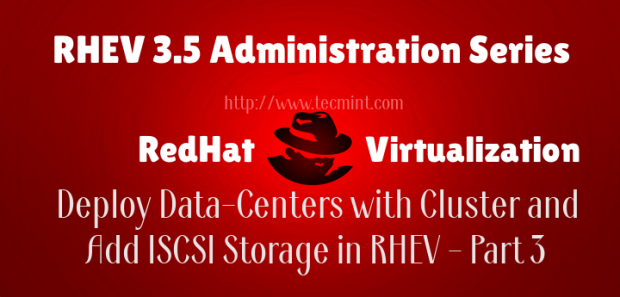
Data Center is a terminology describes the RHEV environment resources such as logical, network and storage resources.
Data Center consists of Clusters which include a set of node or nodes, which host virtual machines and its related snapshots, templates and pools. Storage domains are mandatory attached to Data Center to make it working effectively in enterprise environments. Multiple data centers in the same infrastructure could be managed separately by the same RHEVM portal.
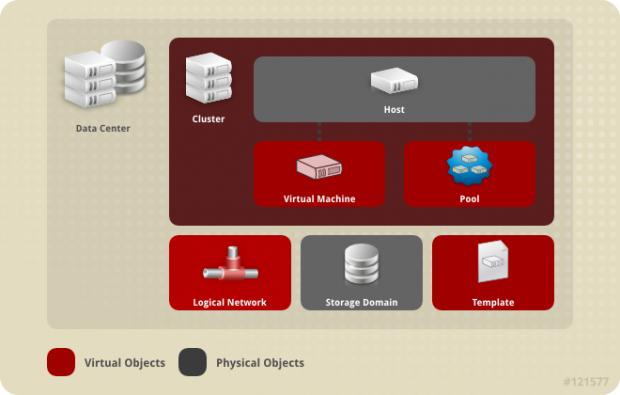
Red Hat Enterprise Virtualization uses a centralized storage system for virtual machine disk images, ISO files and snapshots.
Storage networking can be implemented using:
- Network File System (NFS)
- GlusterFS
- Internet Small Computer System Interface (iSCSI)
- Local storage attached directly to the virtualization hosts
- Fibre Channel Protocol (FCP)
Setting up storage is a prerequisite for a new data center because a data center cannot be initialized unless storage domains are attached and activated. For clustering features and enterprise deployment needs, its recommended to deploy shared-storage in your environment instead of host-based local storage.
In general, storage node will be accessible by Data Center hosts to create, store and snapshot virtual machines beside other important tasks.
Red Hat Enterprise Virtualization platform has three types of storage domains:
- Data Domain: used to hold the virtual hard disks and OVF files of all the virtual machines and templates in a data center. In addition, snapshots of the virtual machines are also stored in the data domain. You must attach a data domain to a data center before you can attach domains of other types to it.
- ISO Domain: used to store ISO files which are needed to install and boot operating systems and applications for the virtual machines.
- Export Domain: temporary storage repositories that are used to copy and move images between data centers in Red Hat Enterprise Virtualization environments.
In this part we are going to deploy Data Domain with following storage node specifications for our tutorial:
IP Address : 11.0.0.6 Hostname : storage.mydomain.org Virtual Network : vmnet3 OS : CentOS6.6 x86_64 [Minimal Installation] RAM : 512M Number of Hard disks : 2 Disk [1st: 10G for the entire system, 2nd : 50G to be shared by ISCSI] Type of shared storage : ISCSI
Note: You could change the above specs as per your environment needs.
Step 1: Creating New Data Center with Cluster of Two Nodes
By default, RHEVM create default data-center contains one empty cluster with name Default in our RHEV environment. We will create new one and add the two (Pending Approval) Hosts under it.
Check the current data-centers, by selecting Data centers tab.

1. Click on New to add new Data center to your environment. Wizard window like this will appear, Fill it as shown:
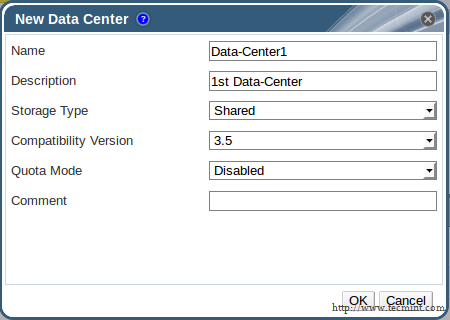
2. You will be asked to create new cluster as apart of “Data-Center1”. Click (Configure Cluster) and fill it as shown..
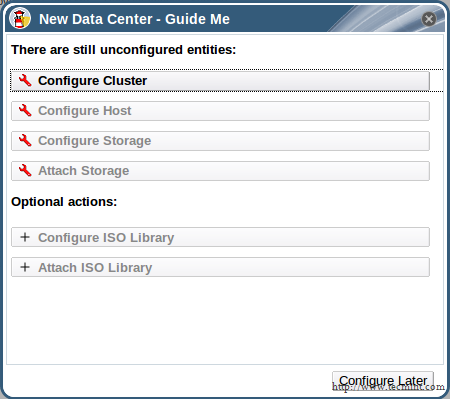
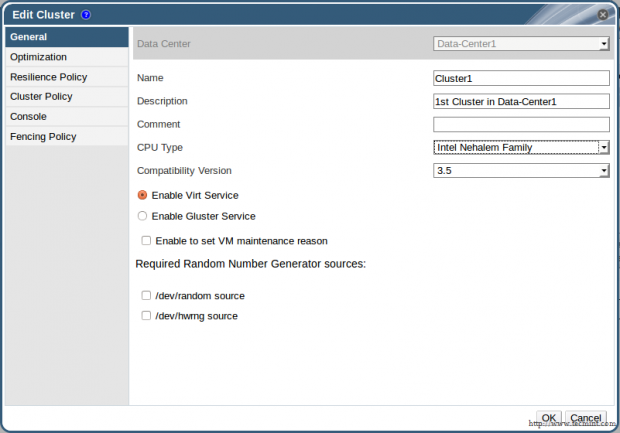
Important: Make sure that CPU Type is correct one and ALL nodes have the same CPU Type. You can modify any setting as per your environment needs. Some settings will be discussed in details later..
3. Click (Configure Later) to exit the wizard.
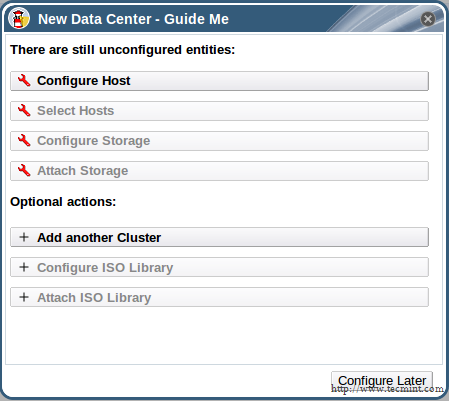
4. Switch to Hosts tab to approve and add (Pending Approval) node to our environment. Select your first node and click Approve.

5. Fill the appeared wizard with the new created “Data-Center1” and its first cluster as shown:
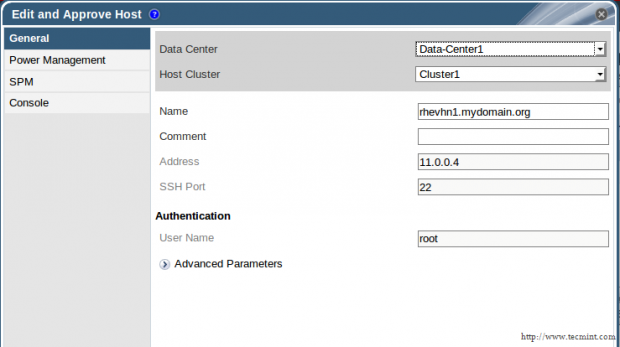
Important: You may see warning about Power Management just skip it by clicking OK, repeat the same steps with the second node..
If everything goes well, status should be changed from “Pending Approval” to (Installing).

Wait another few minutes, status should be changed from “Installing” to (Up).

Also you could check which cluster and data center are assigned to the two node..




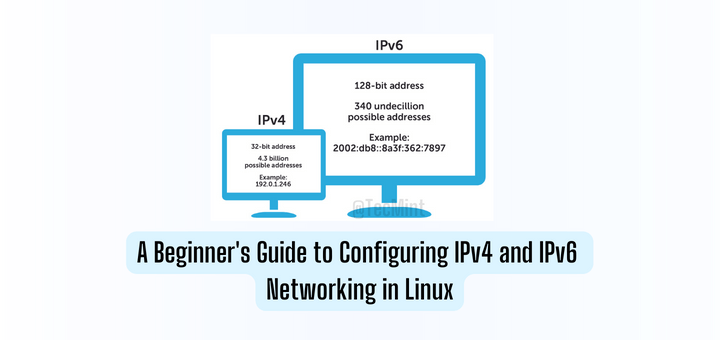

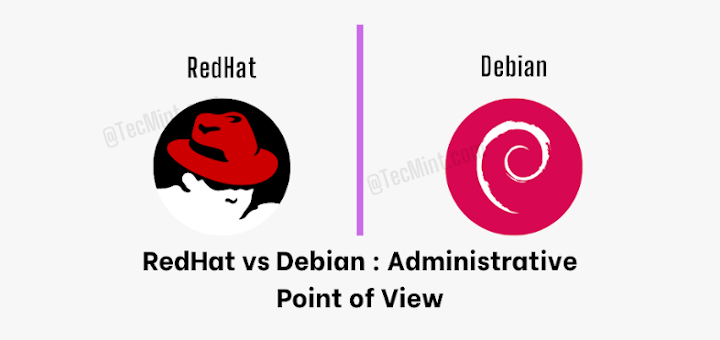
No info on basic configuration of storage node.
Am I missing somewhere?
Hello!
I right understand – RHEV is a proprietary system of red hat, and need buy it ?
@Nick,
You absolutely correct, you need to buy the RedHat RHEV subscription in order use..